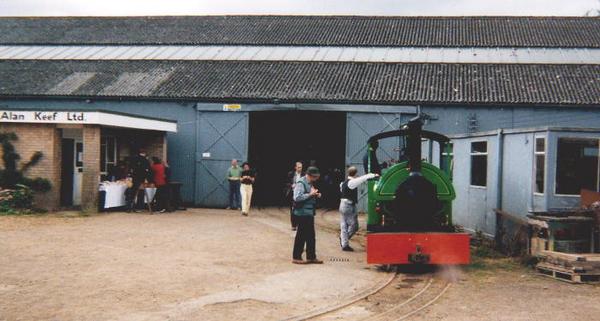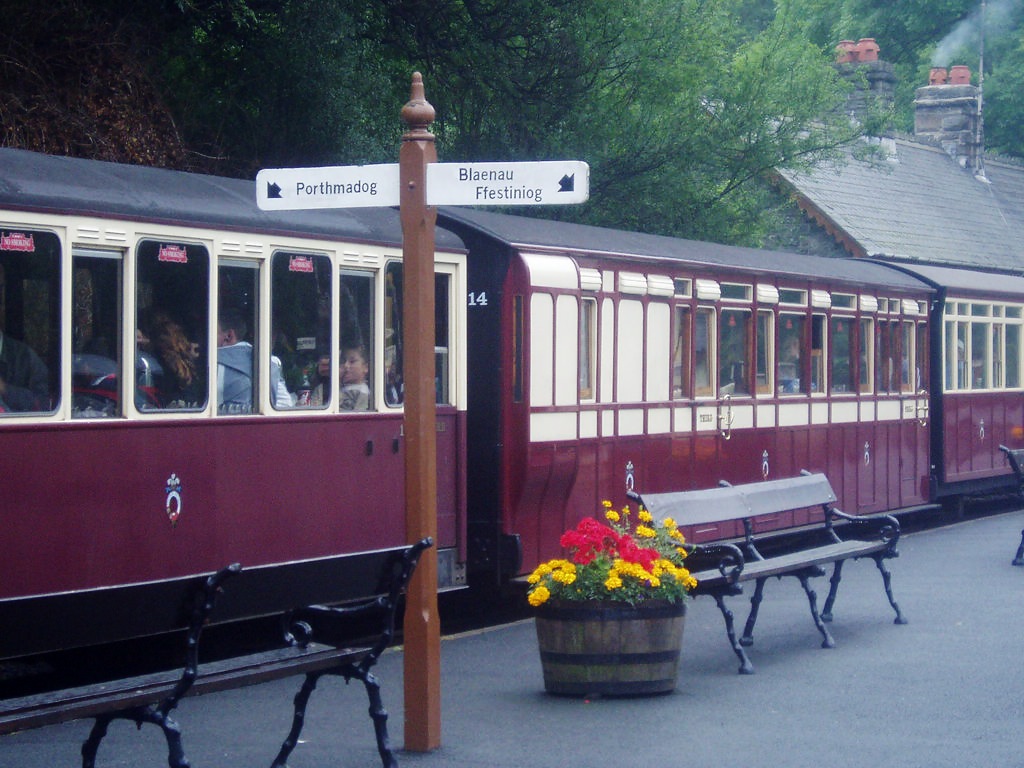|
Winson Engineering
Winson Engineering was a British manufacturer of narrow gauge railway, narrow gauge and ridable miniature railways, miniature railway steam locomotives and rolling stock during the 1990s. It built several new locomotives for heritage railways as well as undertaking major rebuilds of existing locomotives. History Winson was founded in the mid-1980s, although it was not incorporated until 21 March 1990. The engineering works were initially at the harbour in Porthmadog. In 1988, the company moved to Penrhyndeudraeth. In 1995 the company moved again to Daventry. In June 2001 the company went into receivership and subsequently closed. Significant Projects Rebuilds * Rebuild of Welsh Highland Heritage Railway W.G. Bagnall, Bagnall ''Gelert'' * Preparation of Ffestiniog Railway Fairlie locomotive, Fairlie 0-4-4-0T ''Livingston Thompson'' for display in the National Railway Museum * Winson 7 Bure Valley Railway No. 1 2-6-4T ''Wroxham Broad'', planned as steam but completed as steam ... [...More Info...] [...Related Items...] OR: [Wikipedia] [Google] [Baidu] |
Narrow Gauge Railway
A narrow-gauge railway (narrow-gauge railroad in the US) is a railway with a track gauge (distance between the rails) narrower than . Most narrow-gauge railways are between and . Since narrow-gauge railways are usually built with Minimum railway curve radius, tighter curves, smaller structure gauges, and lighter Rail profile, rails; they can be less costly to build, equip, and operate than standard- or broad-gauge railways (particularly in mountainous or difficult terrain). Lower-cost narrow-gauge railways are often used in mountainous terrain, where engineering savings can be substantial. Lower-cost narrow-gauge railways are often built to serve industries as well as sparsely populated communities where the traffic potential would not justify the cost of a standard- or broad-gauge line. Narrow-gauge railways have specialised use in mines and other environments where a small structure gauge necessitates a small loading gauge. In some countries, narrow gauge is the standard: Ja ... [...More Info...] [...Related Items...] OR: [Wikipedia] [Google] [Baidu] |
Bure Valley Railway
The Bure Valley Railway is a minimum gauge visitors' attraction in Norfolk, England. It was created on the original disused trackbed of a standard gauge railway to incorporate a new, adjacent pedestrian footpath. The railway runs from Wroxham to Aylsham () and is Norfolk's second longest heritage railway. It uses both steam and diesel locomotives but has recently purchased a Battery Electric Locomotive to join the fleet. There are intermediate halts at Brampton, Buxton and Coltishall. There are 17 bridges, including a -long girder bridge over the River Bure in Buxton with Lammas, and the Aylsham Bypass Tunnel under the A140 at Aylsham. The railway is listed as exempt from the UK Railways (Interoperability) Regulations 2000. History The railway is built on part of the trackbed of the East Norfolk Railway (ENR). The ENR started in 1877 when the East Norfolk Railway opened from Norwich to Cromer, with an extension from Wroxham to Aylsham in 1880. The western ex ... [...More Info...] [...Related Items...] OR: [Wikipedia] [Google] [Baidu] |
Alan Keef
Alan Keef Ltd is a British narrow gauge railway engineering company which manufactures, overhauls, and deals in narrow gauge locomotives, rolling stock and associated equipment. History The limited company was formed in 1975 at Cote, Oxfordshire, Cote, Bampton, Oxfordshire, continuing what Alan Keef had already been doing for some years as an individual. The first new locomotive was built in 1976. In 1986 the company moved to larger premises at Lea, Herefordshire, Lea, near Ross-on-Wye in Herefordshire. In 1987 it took over the production of Motor Rail locomotives. Production , the company had built more than eighty locomotives – steam, diesel and electric. Most have been miniature or narrow gauge except for two standard gauge steam locomotives for Beamish Museum: the replicas of "Steam Elephant" and "Puffing Billy (locomotive), Puffing Billy". In 2008 the company built the frames, running gear and mechanical parts for two Parry People Mover railcars for use on the Stourbr ... [...More Info...] [...Related Items...] OR: [Wikipedia] [Google] [Baidu] |
Lynton & Barnstaple Railway
The Lynton and Barnstaple Railway (L&B) was a single track, narrow gauge railway. It opened in May 1898 and ran for slightly more than through the area bordering Exmoor in North Devon, England. Although it opened after the Light Railways Act 1896 came into force, it was authorised and constructed before that act. It was authorised under its own Act of Parliament and built to higher (and more costly) standards than similar railways of the time. It was notable as the only narrow gauge railway in Britain that was required to use main-line standard signalling. For a short period, it earned a modest return for shareholders, but for most of its existence it made a loss.G A Brown, J D C A Prideaux, & H G Radcliffe: ''The Lynton & Barnstaple Railway'' published by David and Charles, First Edition 1964, In 1923, the L&B was taken over by the Southern Railway, and eventually closed in September 1935. The Lynton and Barnstaple Railway Trust was formed in 1979; and a short section ... [...More Info...] [...Related Items...] OR: [Wikipedia] [Google] [Baidu] |
Yeo (locomotive)
''Yeo'' was one of three narrow gauge steam locomotives built by Manning Wardle in 1898 for the Lynton and Barnstaple Railway. The other two locomotives were named ''Exe'' and ''Taw''. ''Yeo'', like all the locomotives on the L&B, was named after a local river with a three-letter name, in this case the River Yeo. This naming tradition has been continued in the 21st Century, with ''Lyd'' (a replica of ''Lew'', the fourth locomotive built to this basic design) operational on the Ffestiniog Railway and the Welsh Highland Railway. It had been intended that ''Lyd'' would receive ''Yeo's'' original chimney (which survived on a steamroller for 62 years) but it was found to be too corroded for further use. The naming tradition has also been applied to a Kerr Stuart ''Joffre'' class locomotive currently running on the revived L&B, which has been named ''Axe'', and a Maffei locomotive named ''Sid''. Following the railway's closure in 1935 ''Yeo'' was scrapped along with all of th ... [...More Info...] [...Related Items...] OR: [Wikipedia] [Google] [Baidu] |
Usui Pass Railway Heritage Park
The is an open-air railway museum located in Annaka, Gunma, Japan. It is operated by East Japan Railway Company (JR East), and was opened on 18 April 1998 on the site of the former Yokokawa motive power depot alongside the Shinetsu Main Line, which closed in October 1997. External linksOfficial website {{authority control Museums in Gunma Prefecture Museums established in 1998 Railway museums in Japan East Japan Railway Company 1998 establishments in Japan Annaka, Gunma ... [...More Info...] [...Related Items...] OR: [Wikipedia] [Google] [Baidu] |
Corris Railway
The Corris Railway () is a narrow gauge railway based in Corris on the border between Merionethshire (now Gwynedd) and Montgomeryshire (now Powys) in Mid-Wales. The line opened in 1859 as a horse tramway, running from quays on the River Dyfi at Morben and Derwenlas, through the town of Machynlleth and then following the Dulas Valley north to Corris and on to Aberllefenni. Branches served the slate quarries at Corris Uchaf, Aberllefenni, the isolated quarries around Ratgoed and quarries along the length of the Dulas Valley. In 1878, the railway was rebuilt and steam locomotives were introduced. It was taken over by the Great Western Railway in 1929 and closed in 1948. A preservation society was formed in 1966, initially opening a museum at Corris. A short section of line between Corris and Maespoeth was re-opened to passengers in 2002. The railway now operates as a tourist attraction. Two new steam locomotives have been built for the railway, in 2005 and 2023. Two of th ... [...More Info...] [...Related Items...] OR: [Wikipedia] [Google] [Baidu] |
Corris No 7 - 2006-10-28
Corris is a village in the county of Gwynedd, Wales, about north of the town of Machynlleth. The village lies on the west bank of the Afon Dulas (which here forms the boundary with Powys), around that river's confluence with the Afon Deri. Corris railway station is the headquarters and museum of the Corris Railway, a preserved narrow gauge railway. The area has a community council. The community council system replaced the former parish council system and tackles local issues, as well as acting as a contact point between local government and residents for information and resources on various issues. The community elects one member to represent the Corris/Mawddwy ward on Gwynedd Council. Besides Corris, the ward covers Mawddwy community to the north-east. __NOTOC__ Notable people * Edward Hurst Davies (1855–1927) Quarry manager and owner * Rhisiart Morgan Davies (1903–1958) Welsh physicist * Herbert Harold Disley quarry manager and father of John Disley. * John Disley (192 ... [...More Info...] [...Related Items...] OR: [Wikipedia] [Google] [Baidu] |
National Railway Museum
The National Railway Museum (NRM) is a museum in York, England, forming part of the Science Museum Group. The museum tells the story of rail transport in Britain and its impact on society. It is the home of the national collection of historically significant railway vehicles such as LNER Class A4 4468 Mallard, Mallard, GNR Stirling 4-2-2, Stirling Single, LMS Princess Coronation Class 6229 Duchess of Hamilton, Duchess of Hamilton and a Japanese Shinkansen, bullet train. In addition, the National Railway Museum holds a diverse collection of other objects, from a household recipe book used in George Stephenson's house to film showing a "People mover, never-stop railway" developed for the British Empire Exhibition. It has won many awards, including the European Museum of the Year Award in 2001. Starting in 2019, a major site development was underway. As part of the York Central redevelopment which will divert Leeman Road, the National Railway Museum will be building a new entrance ... [...More Info...] [...Related Items...] OR: [Wikipedia] [Google] [Baidu] |
Ridable Miniature Railways
A ridable miniature railway (US: riding railroad or grand scale railroad) is a large scale, usually ground-level railway that hauls passengers using locomotives that are often models of full-sized railway locomotives (powered by diesel or petrol engines, live steam or electric motors). Overview Typically miniature railways have a rail track gauge between and under , though both larger and smaller gauges are used. At gauges of and less, the track is commonly raised above ground level. Flat cars are arranged with foot boards so that driver and passengers sit astride the track. The track is often multi-gauged, to accommodate , , and sometimes gauge locomotives. The smaller gauges of miniature railway track can also be portable and is generally / gauge on raised track or as / on ground level. Typically portable track is used to carry passengers at temporary events such as fêtes and summer fairs. Typically miniature lines are operated by not for profit organisations - often ... [...More Info...] [...Related Items...] OR: [Wikipedia] [Google] [Baidu] |
Fairlie Locomotive
A Fairlie locomotive is a type of articulated locomotive, articulated steam locomotive that has the driving wheels on bogies. It was invented by Robert Francis Fairlie. The locomotive may be double-ended (a double Fairlie) or single ended (a single Fairlie). Most double-ended Fairlies had wheel arrangements of or . All were tank locomotives. While Fairlie locomotives are now used only on heritage railways, the majority of diesel locomotive, diesel and electric locomotives in the world follow the basic form of the Fairlie — two power trucks with all axles driven. Many also follow the Fairlie's double-ended concept, capable of being driven equally well in both directions. Development of the design In 1864, the Scottish people, Scottish engineer Robert Francis Fairlie published a pamphlet detailing his plans for a new type of articulated locomotive. He had become convinced that the conventional pattern of locomotive could be improved on, and that his proposed design would ... [...More Info...] [...Related Items...] OR: [Wikipedia] [Google] [Baidu] |







